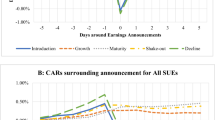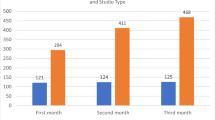Abstract
Substantial research has examined how stock market reactions to marketing actions affect subsequent marketing decisions. However, prior research provides limited insights into whether abnormal stock returns to a marketing action actually predict the future performance resulting from that action. This study focuses on new product preannouncements (NPPAs) and investigates the relationship between short-term stock market returns to an NPPA and the post-launch new product performance under various industry and firm conditions. Findings based on a dynamic panel data analysis of 208 NPPAs in the U.S. automotive industry between 2001 and 2014 reveal that stock returns associated with an NPPA are not an appropriate forward-looking measure of future product performance. However, under specific conditions (i.e., when the preannouncement is specific, the preannounced new product has low innovativeness, the preannouncing firm has a high reputation and invests heavily in advertising, and the preannouncement environment is less competitive), abnormal stock returns to NPPAs actually predict the future performance of new products. Thus, this study extends the marketing–finance and innovation literature with its focus on the conditions that affect the predictive power of immediate stock returns for the future performance of new products.

Similar content being viewed by others
Notes
We thank the Area Editor for this suggestion.
Table 10 in the Appendix 1 summarizes representative research in the marketing–finance literature.
Our replication with CRSP Value Weighted Index provided very similar results.
References
Akdeniz, M. B., Calantone, R. J., & Voorhees, C. M. (2014). Signaling quality: an examination of the effects of marketing-and nonmarketing-controlled signals on perceptions of automotive brand quality. Journal of Product Innovation Management, 31(4), 728–743.
Akins, B. K., Ng, J., & Verdi, R. S. (2012). Investor competition over information and the pricing of information asymmetry. Accounting Review, 87(1), 35–58.
Arellano, M., & Bover, O. (1995). Another look at the instrumental variable estimation of error-components models. Journal of Econometrics, 68(1), 29–51.
Barczak, G., Griffin, A., & Kahn, K. B. (2009). Perspective: trends and drivers of success in NPD practices: results of the 2003 PDMA best practices study. Journal of Product Innovation Management, 26(1), 3–23.
Basuroy, S., Desai, K. K., & Talukdar, D. (2006). An empirical investigation of signaling in the motion picture industry. Journal of Marketing Research, 43(2), 287–295.
Bayus, B. L., Jain, S., & Rao, A. G. (2001). Truth or consequences: an analysis of vaporware and new product announcements. Journal of Marketing Research, 38(1), 3–13.
Belsley, D. A. (1991). Conditioning diagnostics. Inc: John Wiley & Sons.
Bento, A. M., Goulder, L. H., Jacobsen, M. R., & Von Haefen, R. H. (2009). Distributional and efficiency impacts of increased US gasoline taxes. The American Economic Review, 99(3), 667–699.
Bergen, M., Dutta, S., & Walker Jr., O. C. (1992). Agency relationships in marketing: a review of the implications and applications of agency and related theories. Journal of Marketing, 1-24.
Blundell, R., & Bond, S. (1998). Initial conditions and moment restrictions in dynamic panel data models. Journal of Econometrics, 87(1), 115–143.
Chakravarty, A., & Grewal, R. (2011). The stock market in the driver’s seat! Implications for r&d and marketing. Management Science, 57(9), 1595–1609.
Chakravarty, A., & Grewal, R. (2016). Analyst earning forecasts and advertising and R&D budgets: role of agency theoretic monitoring and bonding costs. Journal of Marketing Research, 53(August), 580–596.
Chaney, P. K., Devinney, T. M., & Winer, R. S. (1991). The impact of new product introductions on the market value of firms. Journal of Business, 64, 573–610.
Chen, C.-W., Chiang, M.-H., & Yang, C.-L. (2014). New product preannouncements, advertising investments, and stock returns. Marketing Letters, 25(2), 207–218.
Connelly, B. L., Trevis Certo, S., Duane Ireland, R., & Reutzel, C. R. (2011). Signaling theory: a review and assessment. Journal of Management, 37(1), 39–67.
Corhay, A., & Tourani Rad, A. (1997). Conditional heteroskedasticity adjusted market model and an event study. The Quarterly Review of Economics and Finance, 36(4), 529–538.
Crawford, C. M., & Anthony, D. B. C. (2008). New products management. Homewood, IL: Tata McGraw-Hill Education.
Danaher, P. J., Bonfrer, A., & Dhar, S. (2008). The effect of competitive advertising interference on sales for packaged goods. Journal of Marketing Research, 45(2), 211–225.
Dye, R. A., & Sridhar, S. S. (2002). Resource allocation effects of price reactions to disclosures. Contemporary Accounting Research, 19(3), 385–410.
Eliashberg, J., & Robertson, T. S. (1988). New product preannouncing behavior: a market signaling study. Journal of Marketing Research, 25(3), 282–292.
Erdem, T., & Swait, J. (1998). Brand equity as a signaling phenomenon. Journal of Consumer Psychology, 7(April), 131–157.
Fama, E. F. (1965). The behavior of stock market prices. Journal of Business Research, 38, 34–105.
Fama, E. F., & French, K. R. (1996). Multifactor explanations of asset pricing anomalies. Journal of Finance, 51(1), 55–84.
Fornell, C., Rust, R. T., & Dekimpe, M. G. (2010). The effect of customer satisfaction on consumer spending growth. Journal of Marketing Research, 47(1), 28–35.
Foster, F. D., & Viswanathan, S. (1994). Strategic trading with asymmetrically informed traders and long-lived information. Journal of Financial & Quantitative Analysis, 29(4), 499–518.
Homburg, C., Bornemann, T., & Totzek, D. (2009). Preannouncing pioneering versus follower products: what should the message be? Journal of the Academy of Marketing Science, 37(3), 310–327.
Homburg, C., Vollmayr, J., & Hahn, A. (2014). Firm value creation through major channel expansions - evidence from an event study in the U.S., Germany, and China. Journal of Marketing, 78(3), 38–61.
Hsu, L., Fournier, S., & Srinivasan, S. (2016). Brand architecture strategy and firm value: how leveraging, separating, and distancing the corporate brand affects risk and returns. Journal of the Academy of Marketing Science, 44(2), 261–280.
Joshi, A., & Hanssens, D. M. (2010). The direct and indirect effects of advertising spending on firm value. Journal of Marketing, 74(1), 20–33.
Kale, P., Dyer, J. H., & Singh, H. (2002). Alliance capability, stock market response, and long-term alliance success: the role of alliance function. Strategic Management Journal, 23(8), 747–767.
Klaming, G. (2012). The role of price for premium brands: the case of the automotive industry. Norderstedt, Germany: GRIN Verlag.
Kleinschmidt, E. J., & Cooper, R. G. (1991). The impact of product innovativeness on performance. Journal of Product Innovation Management, 8(4), 240–251.
Koku, P. S., Akhigbe, A., & Springer, T. M. (1997). The financial impact of boycotts and threats of boycott. Journal of Business Research, 40(1), 15–20.
Korenok, O., Hoffer, G. E., & Millner, E. L. (2010). Non-price determinants of automotive demand: restyling matters most. Journal of Business Research, 63(12), 1282–1289.
Le Nagard-Assayag, E., & Manceau, D. (2001). Modeling the impact of product preannouncements in the context of indirect network externalities. International Journal of Research in Marketing, 18(3), 203–219.
Lee, R. P., Chen, Qimei, & Hartmann, N. N. (2015). Enhancing stock market return with new product preannouncements: the role of information quality and innovativeness. Journal of Product Innovation Management, (forthcoming).
Malshe, A., & Agarwal, M. K. (2015). From finance to marketing: the impact of financial leverage on customer satisfaction. Journal of Marketing, 79(5), 21–38.
Markovitch, D. G., & Golder, P. N. (2008). Findings-using stock prices to predict market events: evidence on sales takeoff and long-term firm survival. Marketing Science, 27(4), 717–729.
Markovitch, D. G., & Steckel, J. H. (2012). Do initial stock price reactions provide a good measurement stick for marketing strategies? The case of new product introductions in the US. European Journal of Marketing, 46(3/4), 406–421.
Markovitch, D. G., Steckel, J. H., & Yeung, B. (2005). Using capital markets as market intelligence: evidence from the pharmaceutical industry. Management Science, 51(10), 1467–1480.
McAlister, L., Srinivasan, R., & Kim, M. C. (2007). Advertising, research and development, and systematic risk of the firm. Journal of Marketing, 71(1), 35–48.
McWilliams, A., & Siegel, D. (1997). Event studies in management research: theoretical and empirical issues. Academy of Management Journal, 40(3), 626–657.
Mittal, V., & Kamakura, W. A. (2001). Satisfaction, repurchase intent, and repurchase behavior: investigating the moderating effect of customer characteristics. Journal of Marketing Research, 38(1), 131–142.
Mittal, V., Kumar, P., & Tsiros, M. (1999). Attribute-level performance, satisfaction, and behavioral intentions over time: a consumption-system approach. Journal of Marketing, 63(April), 88–101.
Mizik, N. (2010). The theory and practice of myopic management. Journal of Marketing Research, 47(4), 594–611.
Moorman, C., Wies, S., Mizik, N., & Spencer, F. J. (2012). Firm innovation and the ratchet effect among consumer packaged goods firms. Marketing Science, 31(6), 934–951.
Morgan, N. A., & Rego, L. L. (2009). Brand portfolio strategy and firm performance. Journal of Marketing, 73(1), 59–74.
Ozturk, O. C., Venkataraman, S., & Chintagunta, P. K. (2016). Price reactions to rivals’ local channel exits. Marketing Science, (forthcoming).
Pauwels, K., Silva-Risso, J., Srinivasan, S., & Hanssens, D. M. (2004). New products, sales promotions, and firm value: the case of the automobile industry. Journal of Marketing, 68(4), 142–156.
Rao, A. R., Lu, Q., & Ruekert, R. W. (1999). Signaling unobservable product quality through a brand ally. Journal of Marketing Research, 36(2), 258–268.
Rappaport, A. (1998). Creating shareholder value: a guide for managers. New York: Free Press.
Rego, L. L., Morgan, N. A., & Fornell, C. (2013). Reexamining the market share-customer satisfaction relationship. Journal of Marketing, 77(5), 1–20.
Rhee, M., & Haunschild, P. R. (2006). The liability of good reputation: a study of product recalls in the U.S. automobile industry. Organization Science, 17(1), 101–117.
Roodman, D. (2009). How to do xtabond2: an introduction to difference and system GMM in Stata. Stata Journal, 9(1), 86–136.
Rubera, G., & Kirca, A. H. (2012). Firm innovativeness and its performance outcomes: a meta-analytic review and theoretical integration. Journal of Marketing, 76(3), 130–147.
Sadovnikova, A. & Pujari, A. (2016). The effect of green partnerships on firm value. Journal of the Academy of Marketing Science, (forthcoming).
Sood, A., & Tellis, G. J. (2009). Do innovations really pay off? Total stock market returns to innovation. Marketing Science, 28(3), 442–456.
Sorescu, A. (2012). Innovation and the market value of firms. In S. Ganesan (Ed.), Handbook of marketing and finance. Northhampton, UK: Edward Elgar Publishing.
Sorescu, A. B., & Spanjol, J. (2008). Innovation’s effect on firm value and risk: insights from consumer packaged goods. Journal of Marketing, 72(2), 114–132.
Sorescu, A., Shankar, V., & Kushwaha, T. (2007). New product preannouncements and shareholder value: Don’t make promises you can’t keep. Journal of Marketing Research, 44(3), 468–489.
Sridhar, S., Narayanan, S., & Srinivasan, R. (2014). Dynamic relationships among R&D, advertising, inventory and firm performance. Journal of the Academy of Marketing Science, 42(3), 277–290.
Srinivasan, R., Lilien, G. L., & Rangaswamy, A. (2004). First in, first out? The effects of network externalities on pioneer survival. Journal of Marketing, 68(1), 41–58.
Srinivasan, S., Pauwels, K., Silva-Risso, J., & Hanssens, D. M. (2009). Product innovations, advertising, and stock returns. Journal of Marketing, 73(1), 24–43.
Su, M., & Rao, V. R. (2010). New product preannouncement as a signaling strategy: an audience-specific review and analysis. Journal of Product Innovation Management, 27(5), 658–672.
Talay, M. B., Townsend, J. D., & Yeniyurt, S. (2015). Global brand architecture position and market-based performance: the moderating role of culture. Journal of International Marketing, 23(2), 55–72.
Varadarajan, R. (2010). Strategic marketing and marketing strategy: domain, definition, fundamental issues and foundational premises. Journal of the Academy of Marketing Science, 38(2), 119–140.
Wernerfelt, B. (1988). Umbrella branding as a signal of new product quality: an example of signaling by posting a bond. RAND Journal of Economics, 19(Autumn), 458–466.
Wies, S., & Moorman, C. (2015). Going public: how stock market listing changes firm innovation behavior. Journal of Marketing Research, 52(5), 694–709.
Wiles, M. A., Morgan, N. A., & Rego, L. L. (2012). The effect of brand acquisition and disposal on stock returns. Journal of Marketing, 76(1), 38–58.
Wu, Y., Balasubramanian, S., & Mahajan, V. (2004). When is a preannounced new product likely to be delayed? Journal of Marketing, 68(2), 101–113.
Wu, Q., Luo, X., Slotegraaf, R. J., & Aspara, J. (2015). Sleeping with competitors: the impact of NPD phases on stock market reactions to horizontal collaboration. Journal of the Academy of Marketing Science, 43, 490–511.
Author information
Authors and Affiliations
Corresponding author
Additional information
Raji Srinivasan served as Area Editor for this article.
Appendices
Appendix 1
Appendix 2
Appendix 3
Ordinal 5-point scale for measuring innovativeness
In this study, we measure the “Innovativeness” of a model based on the amount of uncertainty and information regarding its features and future performance. For instance, if the preannounced model has already been on the market in other countries, markets will have more information about that model (e.g., its performance, reliability, features etc), compared to the available information about a “new to the world” model. That said, the “Innovativeness” of each model has been measured and coded using the scale below:
Appendix 4
Survival analyses using model duration in the market
We tested the robustness of our findings using another dependent variable, the entire duration of a car model in the market. Standard regression approaches are not suitable for the analysis of survival times due to right-censoring. Therefore, we used a parametric hazard model, which allows to analyze the effects of time-varying and time-constant covariates on a car model’s probability of failure. The parametric duration models assume a particular shape for the hazard rate and use a distribution (i.e., Exponential, Weibull, Lognormal, Log-Logistic, Gompertz, and Generalized Gamma) to approximate that shape. Each of these different distributions enables the estimation of a particular shape for the hazard rate (i.e. the time dependency). The precision and accuracy of the parameter estimates depend on the correct characterization of the underlying time-dependency. Therefore, it is important to determine the base hazard rate (i.e., the instantaneous probability that a model will fail at time t is constant, increasing, or decreasing with time) to examine a model’s risk of failure over time. Following Srinivasan et al. (2004), we used a multistep approach to determine the distribution that best represents the survival times of new models in the market.
First, we fitted a generalized gamma model, which has the density function below and allows for rather flexible hazard rates since it involves two shape parameters (i.e., κ and p).
where
The generalized gamma model nests several of the other parametric models as special cases: Weibull, exponential, log-normal, and the standard gamma. Thus, it is appropriate for adjudicating between competing parametric models. The results of our estimations indicated that log-normal distribution is appropriate for our models (i.e., κ = 0) suggesting that individual hazard first rises and then declines. Second, we fit exponential, Gompertz, log-normal, log-logistic, and Weibull models separately. We estimated the exponential model, which assumes a constant hazard rate (a special case of the Weibull model, with scale parameter set to “1” and we found that this model was rejected (p < .001)). Therefore, we estimated our model using four distribution functions (Gompertz, log-normal, log-logistic, and Weibull) that accommodate monotonically and non-monotonically changing hazard rates. Although the general pattern of results was similar across models, we find that the model estimated with the log-normal hazard function fits the data better than others based on the Akaike information criterion (AIC). Therefore, we report the results of the hazard models with log-normal distribution estimated in accelerated failure time (AFT) metric with time-varying and -constant covariates and inverse Gaussian shared frailty. The survivor and density functions of the log-normal distribution in AFT metric are:
where Φ is the standard normal cumulative distribution function and. μ = Xβ .
In addition to the error term that accounts for potentially observable yet omitted variables, we included a random intercept, the frailty term to control for unobserved heterogeneity, to account for factors (e.g., idiosyncratic brand characteristics) that were not included in our estimations. We used two commonly applied heterogeneity distributions, namely, Inverse Gaussian and Gamma. Based on the AIC, the Inverse Gaussian distribution outperformed the Gamma distribution, and therefore, we report the results for the Inverse Gaussian model.
Rights and permissions
About this article
Cite this article
Talay, M.B., Akdeniz, M.B. & Kirca, A.H. When do the stock market returns to new product preannouncements predict product performance? Empirical evidence from the U.S. automotive industry. J. of the Acad. Mark. Sci. 45, 513–533 (2017). https://doi.org/10.1007/s11747-016-0507-4
Received:
Accepted:
Published:
Issue Date:
DOI: https://doi.org/10.1007/s11747-016-0507-4




